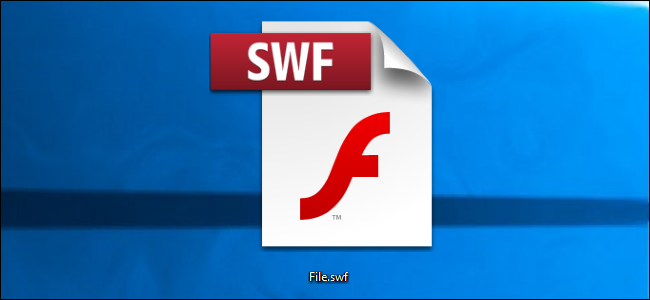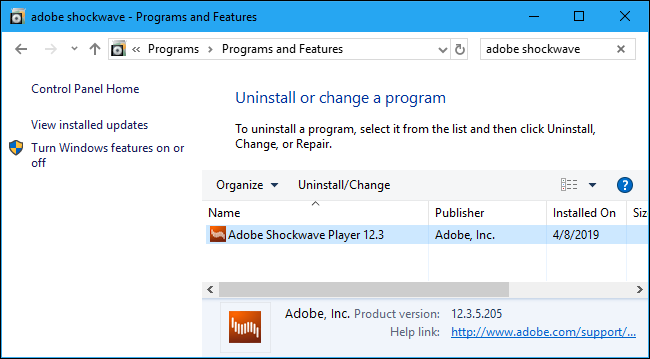Quick Links
Adobe pulls the plug on Shockwave---no, not Shockwave Flash, which is different---today. Dating back to 1995 when it was named Macromedia Shockwave, this plugin was used for games, presentations, and other multimedia on the web.
RIP Shockwave
Adobe is discontinuing Shockwave today, on April 9, 2019. You can no longer download the Shockwave Player for Windows from Adobe, although enterprise customers with support contracts can use it for a few more years. The Shockwave Player for Mac was discontinued back in 2017. If you find an old website hosting Shockwave content, it isn't playable with any officially supported software.
Luckily, the web has moved on from Shockwave, so Shockwave is something you'll only see when browsing web pages from more than a decade ago.
Flash is still around for a while yet. Adobe plans to discontinue Flash by the end of 2020.
Adobe Shockwave vs. Adobe Flash
Both Shockwave and Flash were developed by Macromedia, a company Adobe acquired back in 2005. Each is a multimedia software platform with a web browser plugin. Shockwave content is played by the "Shockwave Player" plugin, while Flash content is played by the "Flash Player" plugin.
Shockwave has become largely irrelevant as Flash gained more and more of its abilities over the years. But the two products have different histories. Shockwave's pedigree goes back further, all the way to VideoWorks for the original Apple Macintosh. CD-ROMs featuring point-and-click adventures and educational experiences created with Shockwave were popular in the early 90s and were created by Macromedia Director. The Shockwave Player plugin was released in 1995 to bring those features to the burgeoning web.
Macromedia introduced features targeted at the video game industry in 2001, and there's a good chance you played a Shockwave game in your browser in the years after that. For example, Candystand.com was owned by Nabisco, the company behind Life Savers, and featured a variety of browser games that used Shockwave. The above YouTube video shows an officially licensed Donkey Kong Country game released in 2003. Yes, Nintendo created browser games in partnership with Life Savers candy.
The web was full of experiences like this---most of which have now been lost to time. Habbo Hotel was an online social community/virtual world aimed at teenagers. Habbo started out using Shockwave and later switched from Shockwave to Flash as the web moved on.
Flash started as a vector-based animation tool named SmartSketch, which become FutureSplash. Macromedia acquired it in 1996. While Shockwave was about heavier multimedia experiences, Flash was all about basic vector graphics and animations---remember Homestar Runner? That was Flash. Flash evolved from there, gaining support for scripting, video, 3D, and other features, absorbing more and more of Shockwave's features and leaving it behind.
Now, even Flash is being left behind by HTML features integrated into modern web browsers. Unlike Flash, these browser features ensure games and other multimedia experiences work everywhere---from your Windows PC to your iPhone to a built-in browser on a video game console---without any browser plug-ins required.
Then What Is Shockwave Flash (SWF)?
Macromedia made things more complicated by confusing "Shockwave" and "Flash," even though they're separate pieces of software. That's why Adobe Flash uses SWF files. According to Adobe, this officially stands for "small web format."
But that's not what it originally meant, as a blog post from an Adobe employee spells out. SWF originally stood for "Shockwave Flash." Macromedia rebranded many of its products with the name "Shockwave." For example, when Shockwave gained the ability to play MP3 files, Macromedia called that "Shockwave Audio." Macromedia later acquired FutureSplash, the company that owned Flash, and named the product "Flash" and the browser plugin "Shockwave Flash." "Shockwave" referred to any sort of in-browser multimedia experience.
It's kind of like how Microsoft was slapping the term ".NET" on everything in the 2000s. .NET was a software framework for Windows application developers, but you also signed into your Hotmail account with an account named a ".NET passport" for some reason. Both companies have changed their minds and since rebranded things, but the .SWF file extension lives on.
It's Time to Uninstall Shockwave
If you do still have Adobe Shockwave on your computer, you should uninstall it. Adobe will no longer be updating it with security patches. Luckily, most web browsers have blocked it and other old web plugins like Java now. At this point, the only browser Shockwave runs in is Internet Explorer---and Internet Explorer is largely an abandoned web browser, too.
Of course, no one's forcing you to uninstall Shockwave. If you have it installed, it should continue working. And, if you find an ancient web page using Shockwave content in the future, it's possible you could hunt down a third-party download site hosting the old Shockwave installer Adobe no longer offers. But Adobe isn't issuing security updates anymore, and that's bad news. The Internet has left it behind---and Flash is next.
But hey, at least you can still use Winamp on a modern Windows 10 PC.




